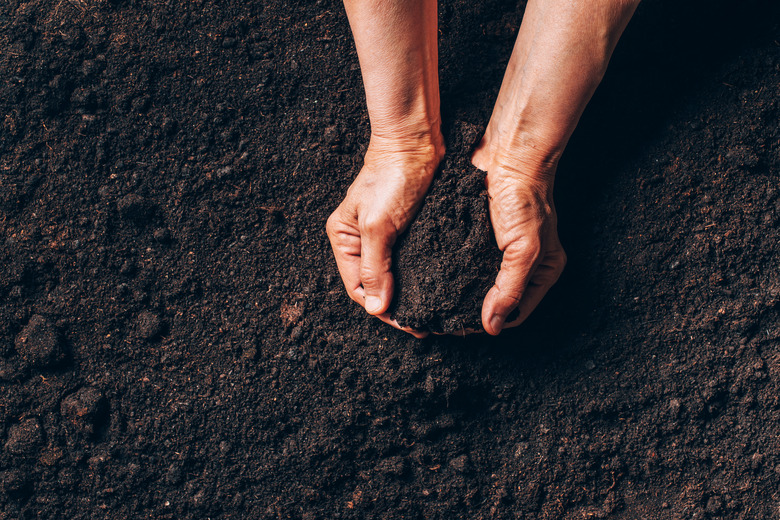5 Uses Of Soil
Soil covers the surface of the planet and can be found in all major environments on Earth. Soil is created by the breakdown of rocks and boulders into smaller and smaller pieces by erosive forces, and the nature of a soil is defined by the parent rocks from which it was made.
However, soil is more than bits of rock and sand, being home to an immense and diverse world, from microscopic animals, bacteria and fungi to creatures such as beetles, millipedes and earthworms, all interacting to produce a complex ecosystem. Uses of soil vary widely, ranging from agriculture and gardening to construction, medicine and the beauty industry.
Agriculture, Parks and Gardens
Agriculture, Parks and
Gardens
With the exception of hydroponics and aquaculture, all plants and food produced on land are dependent on soil. Fruit trees, grain crops and grass for grazing cattle, sheep and other animals all rely on healthy and productive soil.
Soils can vary greatly in their characteristics, and choosing the right crop for the soil type is very important. Crops that grow well in sandy soils include corn, beans, tomatoes, root vegetables including carrots, radishes, potatoes and herbs such as rosemary, oregano and thyme. These plants prefer light, airy soils that drain quickly and that are easy to grow roots into.
Other vegetables, such as broccoli, cauliflower, cabbage and Brussels sprouts prefer heavier clay or silt soils, which retain water well and provide support for the root structure.
As well as growing crops in a field, soil is also essential for home gardens and flowerbeds, public parks and botanical gardens. Trees that provide shade, grass that provides rest and play areas and ornamental flowers all require soil in which to live.
Building and Construction
Building and Construction
With the exception of wood, all materials used in in building and construction come from inside the Earth. Iron, aluminum, tin and other metals are extracted from stones and soils bearing high concentrations of these metals.
Glass is made from sand and limestone. The sand must be a specific size and color, and must be chemically pure – and it is becoming increasingly difficult to obtain.
Limestone is far more abundant and is considered a biological rock, formed over thousands of years by the accumulation of shells, corals, phytoplankton, algae and other sea life with calcareous body casings. Limestone is also an essential ingredient in the production of cement, which is the world's most used substance other than water, and accounts for approximately eight percent of worldwide carbon dioxide emissions.
Another widely used material in building is clay. Clay soils are used in the production of adobe bricks and shingles and terracotta tiles.
Ecosystem Services
Ecosystem Services
Soils can absorb huge quantities of rainwater, helping to regulate water within the landscape and reduce downstream flooding. When water is filtered through rock and soil, it is cleaned of impurities and bacteria, playing an important role in maintaining water quality. The amount of water a soil can absorb is affected by how quickly water can infiltrate into the soil, the internal structure of the soil and how much organic matter it contains.
Soils can also hold, or sequester, large amounts of carbon in the form of organic matter. When plants grow and photosynthesize, they draw atmospheric carbon dioxide from the air and send it into the ground through the roots, in the form of sugars that exude from the roots into the soil. When left undisturbed, this carbon can remain in the soil for extended periods. However, disturbance from clearing or ploughing the soil will cause this carbon to be released back into the atmosphere.
Pottery and Ceramics
Pottery and Ceramics
Clay soil is used in making ceramics, or pottery. When water is added to clay soil, it can be used to create the ceramics. Once formed, it can be left to dry or cooked in a kiln and it will retain its shape. Other types of clays make glazes and enamels that coat the surface and can be mixed with pigments to create a variety of colors. Objects commonly formed with clays include vases, bowls, cups and sculptures.
Medicine
Medicine
Many of today's medicines – such as antibiotics, antidepressants and antifungals – were developed from bacteria and fungi that live in the soil. One gram of soil contains millions of bacteria and thousands of fungi, with many different species and lifeforms. Many of these are unknown to science and it is believed that this world has great potential in the development of new medicines and treatments.
Beauty Products and Treatments
Beauty Products and
Treatments
Many common beauty products use soil as ingredients and have been used for thousands of years. Clay soils are used in many blushes and foundations. These can be varied by using different colors of clay, or adding pigments extracted from minerals such as malachite, azurite and cinnabar.
Soil rich in clay has also be used for centuries for its rejuvenating properties. Mud baths, facial masks and even toothpastes are made from mineral-rich clays, with different clays offering different properties.
References
- CNBC: A Sand Shortage? The World Is Running out of a Crucial — but Under-Appreciated — Commodity
- BBC News: Building's Hard Problem – Making Concrete Green
- AgriFarming: Suitable Crops for Clay Soils, Clay Soil Properties
- AgriFarming: Crops Suitable for Sandy Soil – A Full Guide
- Soils Matter: How Are Soils Used in Cosmetics?
- Soil Components and Human Health: Medicinal Uses of Soil Components, Geophagia and Podoconiosis
Cite This Article
MLA
Michelle, Meg. "5 Uses Of Soil" sciencing.com, https://www.sciencing.com/5-uses-of-soil-12586014/. 30 September 2021.
APA
Michelle, Meg. (2021, September 30). 5 Uses Of Soil. sciencing.com. Retrieved from https://www.sciencing.com/5-uses-of-soil-12586014/
Chicago
Michelle, Meg. 5 Uses Of Soil last modified March 24, 2022. https://www.sciencing.com/5-uses-of-soil-12586014/
